
 |
|
|
Please write: dan@dancooper.tv
Return to Page One
Register here to receive Fashion Finds
email updates!

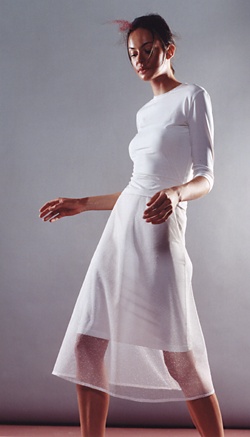 |
Crystal Siemens: I also like Frank Gehry.
FF: Yeah, I do too. I think both Ando and Gehry are wonderful.
Crystal Siemens: Yeah.
FF: And which of Gehry's buildings stick out in
your mind the most, would you say?
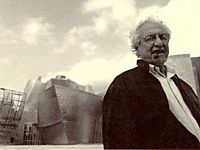 |
Editor’s Note: Los Angeles based architect Frank Gehry has designed buildings all over the world, notably in southern California, Japan, Paris, and Germany. Gehry’s vision began as a counterpoint to the overwrought modernist buildings of the 1960’s. He started to experiment with combinations of inexpensive materials like chain-link fencing, plywood and corrugated steel, and he would reference older architectural forms and consider the structures that would surround his building. His objective with each project is to regard it as "a sculptural object, a spatial container, a space with light and air." Gehry’s most recently completed work is the Guggenheim Museum in Bilbao, Spain. Currently he has three US projects in the works. |
Crystal Siemens: A house that he did in California, in particular. It’s a bunch of blocks. I can’t remember if it’s in San Francisco or LA. But I know what it looks like.
FF: It has a bunch of blocks? It might be the one -- is it the one that’s his? He took like a little cottage in Santa Monica I think it was, and then built all this stuff around it?
Crystal Siemens: I’m not sure if
that’s the one. Of course I like the new Guggenheim Museum in Bilbao, Spain. Like I
think that’s an amazing building.
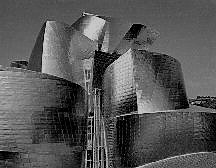 |
FF: It really is, isn’t it?
Crystal Siemens: Yeah, it’s really
fantastic. And I just love it when people play against the conventional. Like that
building in particular, so many curves. It’s kind of like Gaudi, you know when he was
doing his thing.
 |
Editor’s Note: Spanish architect Antonio Gaudi (1852-1926) designed buildings mainly in Barcelona, Spain. Technically innovative, Gaudi created startling architectural forms that were very sculptural in feeling. Undulating facades, the use of color and mixed materials are some of his trademarks. |
So much in contradiction to everything that was going on. But very modern to that time, just as Frank Gehry I think is very, very contemporary for this time, just the materials he used for it.
FF: Definitely.
Crystal Siemens: And again, if you look at that; like how the light reflects on that building...
FF: Absolutely. Even though the two architects are very different in style, I would say that what they have in common is the combination of the organic and the modern.
Crystal Siemens: Yeah, yeah...
FF: Which I think is really cool, but they express it in very different ways.
Crystal Siemens: Yeah. That’s interesting because I’ve never thought of it quite like that. And if I really think of myself in context to that, that’s very much ...
FF: That’s true ...
Crystal Siemens: ... of what I’m about,
because I have such a strong connection to nature. And I think that’s because of
where I grew up.
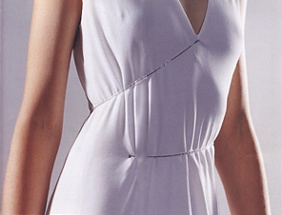 |
FF: Right ...
Crystal Siemens: You know, that whole environment. And then this whole sort of -- what I bring into it on the contemporary level. I mean that’s very much what I think of when designing.
FF: Definitely. And certainly the way you combined certain fabrics, like the taffeta/lycra skirt with the black lining, which is a very sort of modern fabric, but combining it with a very soft linen, which seems more organic to people. It is really a similar kind of theme.
Crystal Siemens: Where I grew up and all that
sort of stuff, when I was living on the farm. I always say I just did nothing. I would
just ride horses. I was like, you know, do the farm stuff. I grew up not really sheltered,
but very na´ve, because there wasn’t really any distraction around. I remember going
out for whole day and just walking miles, you know, by myself or with a friend or
whatever.
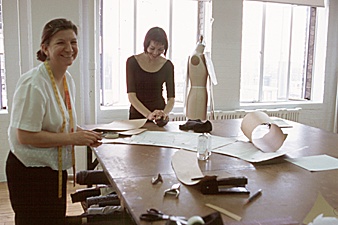 |
One thing I say to people, and they kind of think I’m on drugs, but I say, well, what I’d often do -- because they’d say, well what is your attraction to color and how do you understand sophisticated mixed colors. Because that’s really a forte of mine as well. And I’d say, well, I used to go out, ride a horse, go out in a field or somewhere, and I’d get off and I’d just sit there and look up at the sky. You know and do the usual thing. And then I would look at stalks of grass and I would count how many colors of green I could find in that stalk of grass. And I would sit there for hours. People kind of go, oh man...
FF: No, but I understand.
Crystal Siemens: And then they’d say how can you dissect that. And I’d say it was a matter of taking something so simple like that, and even though it looks like one color green to a lot of people, to me I could take that out and I could count sometimes a thousand colors.
FF: Yes, wow.
Crystal Siemens: I could just section it off. And I would do that. And I remember so clearly doing that. I mean just out of boredom, I don’t know.
FF: Just judging from that one picture of your farm, the color, the light in that part of Canada seems really sort of special; they say the same thing about the light in Provence and all that sort of stuff. So that might have also had some influence on you as well.
Crystal Siemens: It’s so much a part of
your everyday life. Like every morning you get up, and the sky tells you what your
day’s going to be like, and it’s so there in your face all the time. But another
thing about the spring collection was the jersey dresses with the crystal wire that wraps
around the body, and again that just impresses the point of working with detail. I usually
come up with some kind of signature detail every season. And I try to do a detail
that’s subtle, but has great impact. But subtle in its effect in that the crystal
beads on the silver wire against a white dress is a very subtle sort of thing. But it has
such a dynamic impact in terms of how it makes the dress perform on the body.
 |
FF: Definitely.
Crystal Siemens: And the crystals were interesting, because originally the wires were stacked with crystals, and then you know we started busting them off and doing different things. And then the whole idea -- I don’t really like symmetry, I prefer asymmetry, and having some parts where the wire was just exposed and the crystals just fell wherever you wanted them to be. And what I liked about those dresses is, if you walked into a room that was darkly lit, whether you were wearing a black jersey dress or a white one, it’s the light -- whatever lighting you’d be in would refract off the crystals. And it just creates this kind of spiral of sparkle around your body.
FF: Definitely.
Crystal Siemens: And it’s really quite dynamic. And that was the whole inspiration around that as well.
FF: Those are great, and that was true also of
the past fall season, where you did all those things with threads.
 |
Crystal Siemens: That’s right. Yeah.
FF: Yeah, interesting. And so that leads us into fall 1999.
